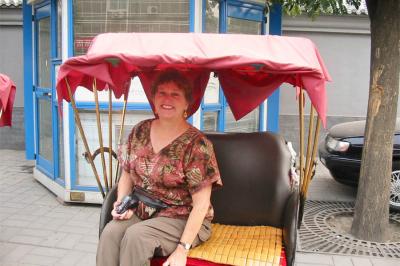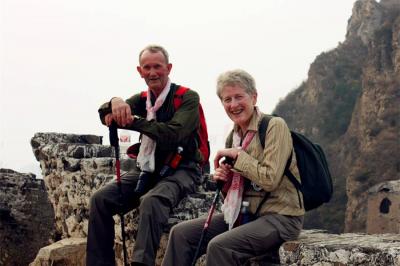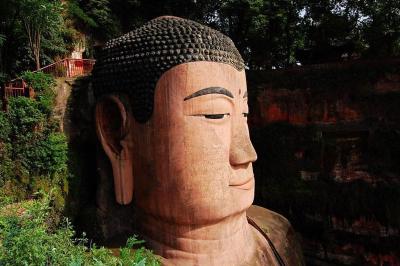Mount Huashan
Mount Hua in Huayin Shaanxi China is famous for its profound Taoism culture and narrow pathways with precipitous drops and death-defying cliff-side mountain hiking trails giving it a deserved reputation for danger, which is regarded as the “World’s Most Dangerous Hiking Trail”. Some people say, if you can hike Mt. Huashan from foot to the top, you are able to conquer every mountain in China. Don't miss it when you travel in Xian or if you are planning hiking tours in China.
Mount Hua is one of the birthplaces of Chinese civilization. The character “hua” in “Zhonghua (China)” and ‘Huaxia (China)’ originates from Mount Hua, earning it the title “Root of Huaxia.” In primitive society, Huashan Mountain was also a sacred mountain for worship. Emperors such as Qin Shi Huang, Emperor Wu of Han, Empress Wu Zetian, and Emperor Xuanzong of Tang conducted large-scale sacrificial ceremonies here.
Not only for its amazing natural scenery and cultural significance, it’s also a famed Taoism mountain. There are more than 20 Taoist temples on the Huashan Mountain, among which Yuquan Courtyard, Duong Temple, East Taoist Temple and Zhenyue Palace are listed as key Taoist temples in China. The 15th of the lunar March is the Pilgrimage Day, and grand temple fairs and celebrations will be hold on that day. It has given birth to many legends in Chinese history, so try to explore its mysteries on your own way.
Except the exciting hiking on Mt. Huashan, you can also visit the famous cultural and natural scenic spots along the way. Splendid natural scenery, temples, Taoist pavilions, elegant buildings, statues and stone carvings can be seen everywhere, such as Jade Spring Temple, Five Dragon Bridge, Fish Stone, Five-Mile Pass, Stone Gate, Shaluo Terrace, Maonv Cave, Qingke Terrace, Mind Changing Stone (Huixin Stone), Thousand-Foot Precipice, Hundred-Foot Crevice, Taoist Temple of A Group of Immortals, Laojun Furrow, Ear-Touching Cliff, Heavenward Ladder, Black Dragon Ridge, Golden Lock Pass, Five-Cloud Peak, Sunshine Welcoming Cave, Chess Pavilion, etc.
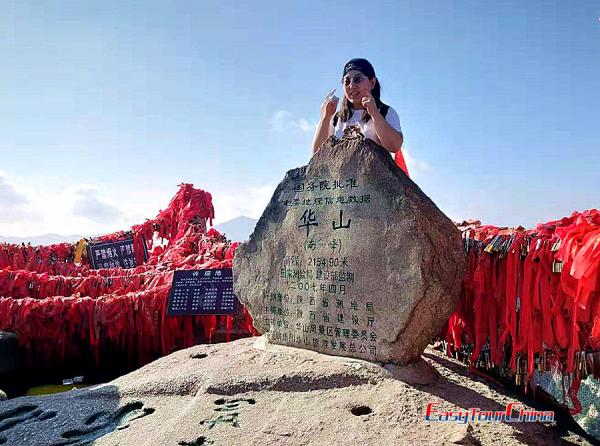
Mount Hua Facts
- - 07:00 – 19:00 (ticket sells at all gates); night hiking after 19:00 (ticket sells at the gate of Yuquan Courtyard)
- - 8-min cable cars on North Peak: CNY 80 for one way; CNY 150 for round way (March to November, 07:00 - 19:00);
- - CNY 45 for one way (December to the next February, 09:00 – 17:00);
- - The North Peak Cableway Tourism Bus Fare: CNY 20 for a one-way trip;
- - 20-min cable cars on West Peak: CNY 140 for one way; CNY 280 for round way (March to November, 07:00 - 19:00);
- - CNY 120 for one way (December to the next February, 09:00 – 17:00)
- - The West Peak Cableway Tourism Bus Fare: CNY 40 for a one-way trip
Brief History of Huashan Mountain
During the Neolithic period (approximately 10,000 to 4,000 years ago), primitive ancestors lived and thrived in the Mount Hua region, using pottery and stone tools to survive through the Yangshao and Longshan cultures.
During the Warring States period, the State of Wei constructed a Great Wall along the west bank of the Changjian River west of present-day Huayin City where Huashan Mountain is located. Twelve sites remain, including the area northwest of Mount Hua's Chaoyuan Cave (present-day eastern Huayin City, stretching from Mount Hua north to the Yellow River, featuring the Wei-built Great Wall; remnants still exist northeast of Dongchengzi east of the present-day Temple of the Western Peak). In the seventh year of Duke Jian of Qin (408 BCE), the Qin state utilized the terrain along the Luo River to construct the “Qian Luo” (i.e., the Qin Great Wall). From the twelfth to the nineteenth year of King Hui of Wei (359–352 BCE), the State of Wei built hundreds of miles of Great Wall at the confluence of the Wei and Luo Rivers. During the reign of Emperor Zhao of Qin (306–251 BCE), craftsmen were ordered to scale Mount Hua using hooks and ladders, leaving an engraved inscription. This marks the earliest documented climbing of Mount Hua in extant records. However, no formal mountain trails on Mount Hua existed until the Tang and Song dynasties.As a holy mountain of Taoism and one of the most famous mountains in China, Mount Huashan has a long religious history. As early as the 2nd century B.C., there was a Daoist temple known as the Shrine of the Western Peak located at its base, which was often used for spirits mediums to contact the god and his underlings. It is said that the founder and patriarch of Taoism, Lao Zi (Lao Tzu), once lived and gave sermons here. It is also the place where many emperors came to pray and sacrifice to the god of Mt. Hua. Now, a variety of Taoism temples and other religious structures are located on its slopes and peaks.
How Was Hushan Mountain Formed and Geology
According to scientific research, approximately 3 billion years ago, the area around Mount Hua was once a vast ocean. Around 2.5 billion years ago, through continuous crustal movements, seafloor tremors and magma eruptions formed volcanic sedimentary layers up to 5,000 meters thick.
By approximately 300 million years ago, the landmass had steadily expanded while the oceanic area shrank. Under intense tectonic compression, rift-zone movements caused the crust to rise continuously.
Then approximately 220-65 million years ago, by the Cretaceous period, the Huashan rock mass began to rise, while the major fault zone at its northern base started to subside. After prolonged crustal movements and natural processes like river erosion and wind and rain weathering, the mountain attained its present form around two to three million years ago.
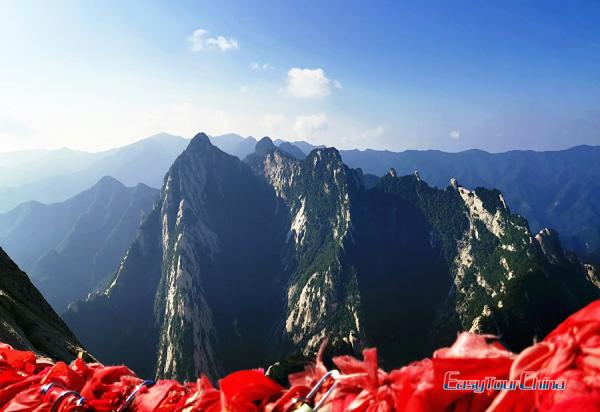
What to Do & See?
Located at the confluence of the Yellow River Delta spanning Shaanxi, Shanxi, and Henan provinces, near the city of Huayin, and about 120 kilometres east of Xi'an city, Mt. Hua is the Western Mountain of the Five Sacred Mountains (the other four being Mt. Taishan, the Eastern Mountain in Shandong Province; Mt. Hengshan, the Southern Mountain in Hunan Province; Mt. Hengshan, the Northern Mountain in Shanxi Province and Mt. Songshan, the Central Mountain in Henan Province).
Five peaks of Mount Hua
The mountain mainly consists of five peaks which look like five petals of a flower, and each one has its distinctive charms:
East Peak (Facing Sun Peak). It is 2,100 meters high above sea level and the top of the peak is the best place to watch the sunrise.
West Peak (Lotus Flower Peak). Formed by a huge rock, the 2,082.6 meters high peak is very steep. The touching legend 'Hanxiang cleave the mountain and save his mother' comes from the peak. It is the most elegant.
South Peak (Landing Wild Goose Peak). It is the highest of the five peaks with an altitude of 2,154.9 meters, inhabited the temple for God of Mt. Huashan.
North Peak (Cloud Terrace Peak). It is the lowest of the five peaks with an elevation of 1614.9 meters and the most important site on the North Peak is the Zhenwu Hall.
Middle Peak (Jade Maiden Peak). It is said that Nongyu, the daughter of King Mugong (659B.C.-621B.C.) of the Qin Kingdom during the Spring and Autumn Period (770B.C.-476B.C.), was tired of the life in the court and lived reclusively in Middle Peak with her husband. It is 2037.8 meters high above sea level.
Hiking Mount Huashan: Plank Walk
Changkong Plank Road
Located on the eastern slope of Huashan's South Peak, the Changkong Plank Road was constructed by the first patriarch of the Huashan School, the Yuan Dynasty Taoist master He Zhizhen. Seeking seclusion from the mortal world to cultivate immortality, he embedded stone pegs into the sheer cliff face and built wooden planks upon them. Stretching 110 meters in length at an altitude of 2,160.5 meters, the plank road is flanked by sheer cliffs above and below, secured only by iron chains suspended like a ladder in mid-air. It ranks among the world's ten most perilous attractions.
The first section of the trail is a 20-meter-long, two-foot-wide path carved into the cliff face, barely wide enough for one person. Here, the path and the rock-hewn walkway are secured by iron chains, making it relatively safe. The second section features a vertical stone path with a bottomless abyss stretching out before you. This second section is more perilous, especially with visitors passing in opposite directions. Climbers must attach their safety harness hooks to the safety rope on the right. Descending another 10 meters leads to the third section of the sky ladder of the Mount Hua Plank Road. Here, the plank road is flanked by sheer cliffs on both sides—one section is a wooden plank walkway, while the other is supported by stone or iron pillars below.
>> Related reading: Hiking in China: 6 Best Hiking Trails with Views
Hawk Turn (鹞子翻身)
Hawk Turn is known as “Mount Hua's Second Most Perilous Passage.” Located on the East Peak, this sheer cliff face is the only route down to the Chess Pavilion. Its steep, wing-like shape earned it the name “Hawk Turn.” Visitors must face the cliff, grip the rope, and descend by alternating steps into rock crevices.
Laojun's Furrow (老君犁沟)
Originally named “Laojun's Departure from Filth,” meaning “leaving worldly impurities to reach immortality” in Taoist terminology, this is another perilous hiking trail on Mount Hua. A deep, treacherous gully cuts through sheer cliffs, featuring over 570 stone steps.
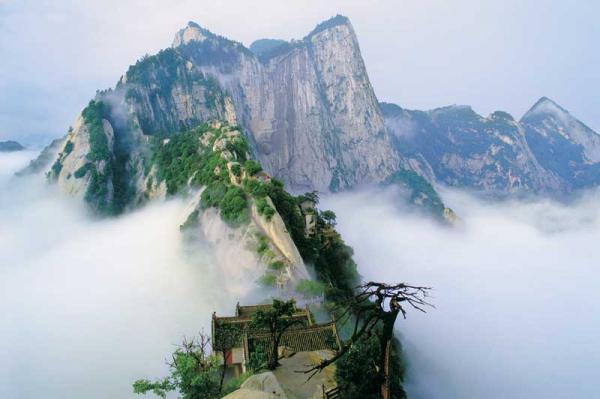
Thousand-Foot Pillar (千尺幢)
Thousand-Foot Pillar is a massive crevice carved into a sheer cliff face, wedged between towering boulders. Its vertical walls form an extremely steep slope, barely wide enough for two people to pass side-by-side. Over 370 steps descend from top to bottom, each step about one-third the width of a foot and inclined at a 70° angle. Vertical iron chains hang down both sides, leading to a narrow stone passage at the top that fits only one person. Climbers emerge through this passage after ascending the final step, hence its name “Skywell.” Blocking this “well opening” would sever the path to Mount Hua.
Baizhi Gorge (百尺峡)
Also known as “Bai Zhang Cliff,” this section features sheer, vertical cliffs that appear as if cleaved by an axe, nearly reaching a 90-degree angle. The passage is a perilous rock crevice just 46 meters long, with 91 stone steps. Its construction began in the late Ming and early Qing dynasties, underwent reinforcement during the Republic of China era, and has been repeatedly repaired since liberation. Visitors must grip iron chains to keep climbing on Mount Huashan.
West Peak Temple (Xiyue Temple)
West Peak Temple served as the imperial site for sacrificial rites to Shaohao, the deity of Mount Hua, throughout successive dynasties. Founded in 134 BC, it boasts a history spanning over 2,100 years. Expanded and renovated during various reigns, it was finally reconstructed in the 42nd year of the Qianlong reign of the Qing Dynasty to fully replicate the architectural layout of the Forbidden City in Beijing. Consequently, it is known as the “Little Forbidden City of Shaanxi.” Simultaneously, Xiyue Temple stands as the largest extant Ming-Qing dynasty imperial palace-style garden complex in Northwest China.
As the most expansive temple among the Five Sacred Mountains, it holds the esteemed title of “Greatest Temple of the Five Mountains.” The architectural layout of West Peak Temple follows an outer city wall with an inner enclosure and central axis symmetry. As a second-tier sacrificial structure, its status is second only to imperial palaces and altars. It preserves ancient historical buildings such as the Golden City Gate, Lingxing Gate, stone archway, Haoling Hall, stele pavilion, imperial study, and Wanghe Tower.
How to Visit Mount Huashan
There are 4 routes to Climb Mount Hua:
1. Huashan Scenic Area Visitor Center → West Peak Cable Car (40-minute shuttle bus ride into the mountains) → South Peak → East Peak (approx. 1 hour 30 minutes walk, offering views of West Peak scenery/East Peak sunrise)
2. Huashan Scenic Area Visitor Center → West Peak Cable Car (40-minute shuttle ride into the mountains) → South Peak → East Peak → Central Peak → North Peak Cable Car Descent (Cable car back to Visitor Center approx. 1 hour, walking approx. 2 hours 40 minutes)
3. Huashan Scenic Area Visitor Center → North Peak Cable Car (20-minute shuttle ride to North Peak Cable Car) → North Peak (Yuntai Peak) → Central Peak → East Peak → South Peak (approx. 3 hours 40 minutes by cable car, enjoy views of West Peak/sunrise at East Peak)
4. Mount Huashan Hiking Route: Yuquan Temple → Thousand-Foot Pillar → North Peak (approx. 4 hours/6 km hike) → Ear-Brushing Cliff → Cangyun Ridge → Golden Lock Pass → East Peak (approx. 3 hours/6 km hike, overnight stay at East Peak for sunrise) → Hawk Turn → West Peak (approx. 1 hour 40 min walk) → Wuyun Peak → Descend via original route (approx. 3 hours/8 km hike)
>> Recommended Xian tours:
Best Time to Visit Mount Hua
April to October each year is the best time for sightseeing and hiking on Mount Hua, featuring clear weather and picturesque scenery. However, temperatures drop significantly at night on the summit even in summer, so warm clothing is essential. East Peak offers the best point for sunrise viewing, while North Peak provides the optimal location for taking in the panoramic views of Mount Hua. >> Learn more about Xian Weather and best time to visit
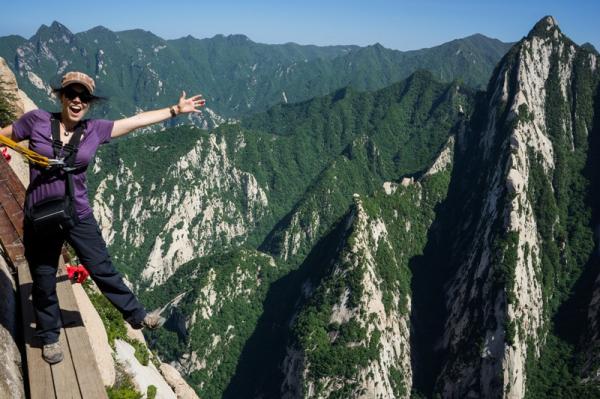
Travel Tips
1. Wear proper soft bottom sports shoes, and they will protect your feet while hiking on Mt. Huashan. Whether to prepare gloves, socks, crutches and other equipment is up to your personal circumstances.
2. Eat some high-calorie food before hiking, and bring some snacks, which can effectively increase your physical strength.
3. Hiking on Mt. Hua can easily get thirsty, so bring some bottles of water, but do not drink too much on the way, small sips are best.
4. The temperature can change quickly up on the mountain, so you’d better prepare some warm clothes, and if you climb Mt. Huashan in summer, you’d better bring a lightweight raincoat because of the heavy moisture.
How to Get to Mount Huashan from Xi’an?
By driving. It will take around 2hrs from Xian city center to the park of Huanshan Mountain Scenic Spot. The easiest one.
By coach. Take a coach from Xi’an Bus Station to Mt. Huashan tourist center. The coach runs between 07:00 and 19:15 (CNY 39 one way). The bus leaves every half an hour. Come to Huashan in free-worry way and save money. Take scenic bus at tourist center when you come back; the bus will send you to Xian Station for free.
By high speed train. Take high-speed train from Xi’an North Railway Station to Huashan North Station (CNY 54.5 for the second class seats), then take tourism bus No. 1 or 2 to tourist center of Mount Hua. Come to Huashan in economic and fast way.
By airplane. Take plane from Xi'an Xianyang International Airport to Huashan Tourist Center. Come to Huashan city at full speed.
Plan your Mount Huashan Tour with ETC
Experience custom-made China tours to Xian, from Mount Hua to Terracotta Warriors. Explore the historical landmarks and stunning nature on privately guided trips—all tailored by your Easy Tour China expert.
